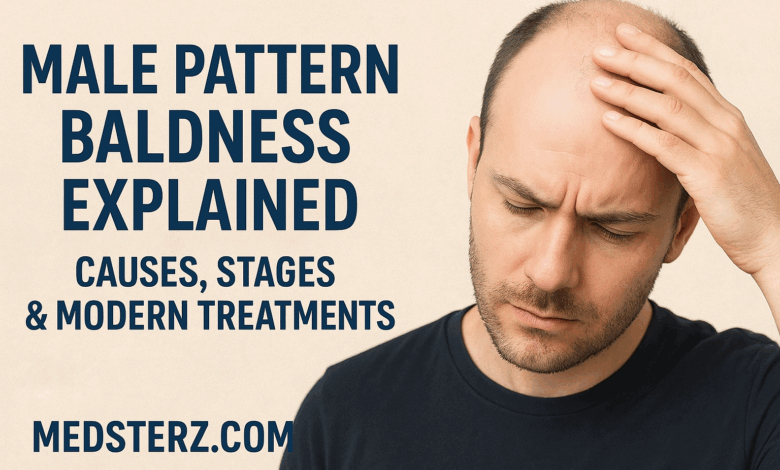Male Pattern Baldness Explained – Causes, Stages & Modern Treatments
Understanding why men lose hair and the latest treatments that actually work.

Introduction
Male pattern baldness, also known as androgenetic alopecia, is the most common form of hair loss in men, affecting nearly 50% of men by age 50. While genetics play a major role, hormonal changes and lifestyle factors can accelerate the process. Let’s break down its causes, stages, and the most effective modern treatments backed by science.
1. What Causes Male Pattern Baldness?
The primary culprit is dihydrotestosterone (DHT) — a byproduct of testosterone. DHT binds to receptors in hair follicles, causing them to shrink and eventually stop producing new hair.
Other contributing factors include:
-
Genetics: Family history strongly influences susceptibility.
-
Age: Hair follicles become more sensitive to DHT over time.
-
Lifestyle factors: Poor diet, stress, and smoking can accelerate hair loss.
Scientific Insight:
A 2020 study in Nature Communications identified over 200 genetic loci associated with male pattern baldness, confirming that heredity plays a major role.
2. Stages of Male Pattern Baldness
Hair loss typically follows the Norwood-Hamilton scale, which classifies male pattern baldness into 7 stages:
-
Stage 1: No visible hair loss.
-
Stage 2: Mild recession at the temples.
-
Stage 3: Deepening temple recession (classic M-shape).
-
Stage 4: Significant hairline recession and thinning at the crown.
-
Stage 5: Hairline and crown bald areas start merging.
-
Stage 6: Only thin strips of hair remain on the sides.
-
Stage 7: Advanced baldness with sparse hair on sides and back.
3. Modern Treatment Options
a) Medications
-
Finasteride (Propecia):
Blocks the enzyme that converts testosterone to DHT. Proven to slow hair loss and promote regrowth in some men.
Scientific Data: A 2019 study in Journal of the American Academy of Dermatology showed that 83% of users maintained or increased hair count after 2 years. -
Minoxidil (Rogaine):
A topical treatment that increases blood flow to hair follicles. Works best in early stages.
b) Hair Transplant Surgery
-
FUE (Follicular Unit Extraction): Minimally invasive, leaves no linear scar.
-
FUT (Follicular Unit Transplant): Involves removing a strip of scalp and dividing it into grafts.
Turkey is currently one of the global leaders in affordable, high-quality hair transplants, attracting patients from all over the world.
c) PRP Therapy (Platelet-Rich Plasma)
Your own blood’s platelets are injected into the scalp to stimulate growth factors that promote follicle regeneration.
d) Low-Level Laser Therapy (LLLT)
Laser caps and combs improve scalp circulation and cellular energy production, supporting hair density.
4. Preventive Lifestyle Measures
-
Eat a protein-rich, nutrient-dense diet (iron, zinc, biotin, omega-3s).
-
Manage stress through exercise, meditation, or yoga.
-
Avoid tight hairstyles and harsh chemical treatments.
-
Use gentle hair products that maintain scalp health.
5. Emerging Research
-
Stem cell therapy and exosome-based treatments show early promise in regenerating dormant follicles.
-
Clinical trials are exploring JAK inhibitors and Wnt signaling activators for future non-surgical options.
Conclusion
Male pattern baldness may be common, but it’s no longer inevitable. With early intervention, a balanced lifestyle, and modern medical treatments, hair loss can be slowed — and even reversed in some cases.
